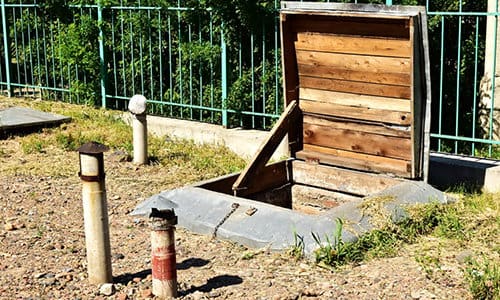It is true of today’s military conflicts that you can be in the middle of a terrible amount of violence and destruction without ever laying eyes on an enemy combatant. Long-range weapons have become the offensive tactic of choice, simply because the side using them to attack, can keep their soldiers safe while raining down destruction on their opponents.
This article will look at easy ways to construct a rudimentary bomb-proof shelter that could save the lives of you and your loved ones.
Explosions – Surviving a bomb blast requires that you protect yourself from the four main ways in which they cause damage, namely: blast and shock wave, heat, debris and other damage, blast wind.
So let’s find out how explosions kill.
Blast and Shock Wave
The first thing to hit you after an explosion is the blast wave, followed closely by the shockwave. This is almost the same thing, but the difference is that the blast wave moves against your body, and transfers the energy into the shockwave that then passes through your body. The same applies to any physical object that is in direct line of sight to the blast.
A shockwave moving through a human body causes tissue damage and can rupture organs, break bones, burst blood vessels, etc. A shockwave moving through your immediate surroundings can cause a wall to fall on you or a building to collapse on its occupants.
Heat
This can be in the form of a fireball or superheated air. Breathing superheated air can cause cauterization inside the lungs and severe burns. The fireball will conflagrate everything in its paths, and cause secondary fires and explosions.
Debris and Other Damage
Debris can be in the form of flying glass, flying refrigerators, pieces of masonry and plaster, etc.
Related: 10 Items To Stockpile For When The Power Goes Out

Blast Wind
The blast wind is the force that results from the vacuum that the explosion creates. The vacuum will fill itself and may cause a rushing wind toward where the explosion happened in the first place. This could see people, debris, and heat being “sucked” toward the blast center.
Bomb Shelters
The best bomb-proof shelter is the one that allow you to avoid all of the above. Thinking about it, you will soon realize that an underground shelter is the best. And it doesn’t even have to be very deep. It could be as shallow as a few feet, and still protect you from the blast and shock waves, and also the debris. Heat is a bit more tricky, but if you cover your shelter with a layer of soil and concrete and install a blast door, this should not be an issue.
A bomb-proof shelter needs to protect you from the initial blast and also be equipped to allow you to survive for some time thereafter, as you could get stuck inside or could have to remain there to avoid further blasts etc.
Note that if a large bomb detonates right on top of you, only an industrial-grade, deep, and well-designed bomb-proof shelter will be able to save you. This article doesn’t deal with those types of shelters.
Locations
Root cellars and basements are ideal to convert into a bomb-proof shelter. All you need to do is to install a blast door that will be able to withstand heat and debris.
If you don’t have a root cellar, use the room in your house with the smallest windows, or ideally a room that is not an outer wall. Sometimes this will be a passage or bathroom.

Struts
If your bomb-proof shelter is in a root cellar or basement, weight on the floor could cause the roof of your shelter to cave in. Wooden poles or steel pipes can be used to reinforce the structure and increase its weight-bearing capacity.
Measure the height you need, and cut your poles or pipes a fraction longer. Prop them against the roof and push the base in. Because your pole is longer, it will stop before it’s in position. Use a hammer at the base to whack it into the correct position. A spirit level could help you to keep your poles plumb.
Related: 10 Home Repairs That You Can Do In 10 Minutes Or Less
Supplies
Setup supplies in a box or drum, and be sure to include a fire extinguisher or water. I have a few old towels in mine. Wet towels can prevent burns from fireballs or heated air and can be used as a makeshift breathing filter if you are overcome by smoke.
Extremely loud noises can damage the ears, so industrial earplugs or shooting range earmuffs will help.
Other standard items would be drinking water, food, a first aid kit, and whatever else you might need to pass the time.

Equipment
I have a fear of getting trapped inside a structure. So I always have excavation equipment. A sledgehammer, fubar, pickaxe, shovels, and prybars. I keep a mining-type hardhat with a headlamp inside the shelter.
Keep a hacksaw or battery-operated grinder. You never know when you might need to cut through reinforcing.
The concept is that you can excavate a way out, should the access through the door become unviable.
Related: 26 Necessary Tools For Off-Grid Living
Doors
It is best to construct a door that opens into the bomb shelter. This will require strong hinges and two or three locking mechanisms like deadbolts. A door that opens outward or away from the bomb shelter could become obstructed with debris, trapping you inside.
6mm and thicker steel should be adequate and will also afford resistance to bullets. The door must run parallel to the floor, or at an angle, but preferably not perpendicular. Flat and angled doors avoid or deflect shockwaves. A door perpendicular to the shockwave will absorb maximum energy and therefore increase the risk of damage.
Ensure that the frame, hinges, bolts, and door is strong. Drop bars will help barricade the door and enable it to absorb greater amounts of impact without opening.

Covered Trenches
Even a shallow trench will allow you to avoid most of the shockwave and blast wind. If you can cover the trench with a door of some sort it will add protection from debris and heat. You can simulate a trench type of effect by placing a bed close to a wall and lying between the bed and wall when you expect a blast. (You can lie under the bed if you fit in there). Don’t place the bed such that a shockwave will crush you between the bed and the wall.
Ventilation
You need to take care of ventilation, particularly if a few people will be spending some time inside the shelter. Carbon dioxide buildup can cause death.
Proper ventilation will consist of two ventilation ducts or points. Both must lead to the outside of the shelter. One must be close to the floor of the shelter and the other close to the top, allowing convection to assist with air movement. Some drainpipes and computer server fans that run on 24V DC can easily be wired to create a well-functioning ventilation system.
Carbon dioxide detectors can warn you of any danger.
Avoid using candles for lights, or fires for heat, unless you have thought it through and have adequate airflow.

Closets
Preferably set up closets that do not face a window, or any other opening into your house, where a blast and shockwave can enter.
Fortify the hinges and add weight to an existing door with a steel plate placed on the inside.
Closet doors open outward, so beware of getting locked in by debris. A closet from which you can climb into the ceiling of your house is an option for escape.
Other Supplies
Keep some dust masks and safety goggles in a pouch inside your shelter. Explosions are invariably dusty occurrences, and some fresh air will help to keep you focused on surviving.
I also keep electrician’s tools, plumbing supplies, batteries, and an electrical multi-tester handy. Explosions are famous for causing damage to pipes and electrical cables.
So there you have it, folks. A little bit of preparation will go a long way in keeping you safe during a bombing raid and enable you to survive the aftermath.
You may also like:
 How To Install A Trip Wire Alarm On Your Property
How To Install A Trip Wire Alarm On Your Property
You Will Not Survive An EMP Strike Without This (Video)
Avoid These 6 Signs On Your Property








